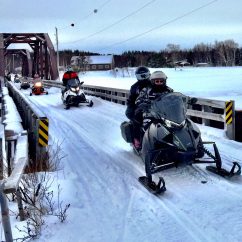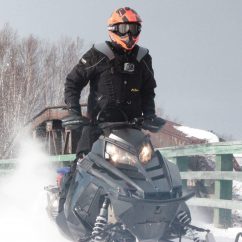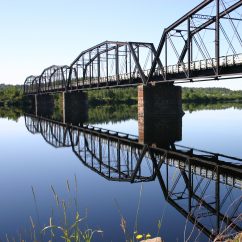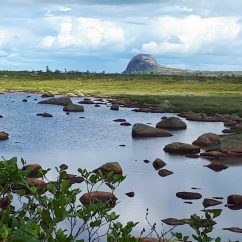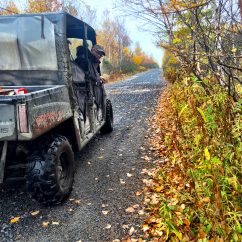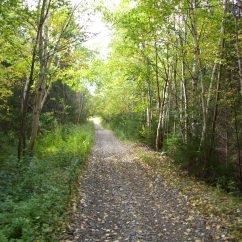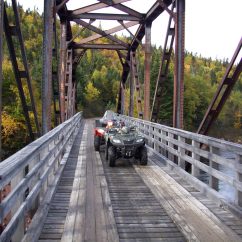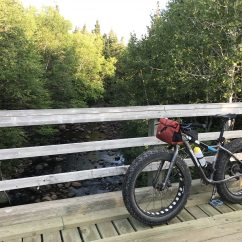The Newfoundland Railway carved a pathway through the wilderness, and the very heart of the island of Newfoundland. Stretching almost 900 kilometres, this was the longest narrow-gauge railroad in North America. The railroad has long been decommissioned but the rail bed remains, stretching from Port Aux Basques to St. John’s. This island-wide corridor runs through all manner of scenic landscapes and natural beauty; from thick forests to wide-open barrens. It winds its way through over 30 municipalities, connecting communities all across the island of Newfoundland. The T’Railway is part of The Great Trail of Canada and links urban, rural and wilderness environments. The legacy of the railroad can be seen in the trestles, bridges, station houses and rail cars found in this beautiful, linear park. It’s beauty and accessibility are maintained with the help of the Newfoundland T’Railway Council and the Newfoundland and Labrador Snowmobile Federation.
Find out more about the park by visiting Natural History.
Photo Gallery
History
Rail travel in Newfoundland and Labrador had numerous stops and starts with connections being made between towns by many different stakeholders. Between 1880 and 1888 The Newfoundland Railway Company, The Harbour Grace Railway and the colonial government of Newfoundland had all laid lengths of rail on the Avalon Peninsula. It was the Northern and Western Newfoundland Railway under Robert G. Reid that completed the route to Port-aux-Basques, with the first passenger train completing the journey on June 29, 1898. At the request of the colonial government under the Railway Contract of ’98, Reid took over the operation of the entire route, forming the Reid Newfoundland Company in 1901.
In 1923 the Railway Settlement Act was passed, giving the colonial government control of the renamed Newfoundland Government Railway. This was later shortened to the Newfoundland Railway in 1926, the name that carries the most weight in terms of its legacy.
On March 31, 1949, Newfoundland joined Confederation and the Terms of Union saw the railway transfer to Canadian National Railway. CN renamed the railways premiere passenger train, The Overland Limited to The Caribou, known locally and affectionately as The Newfie Bullet. Passenger service was ended in 1969 in favour of buses.
Ten years later in 1979, the CN subsidiary TerraTransport was created to maintain the railways in Newfoundland and Labrador which it did until rail service was finally abandoned on October 1, 1988 with the last rails removed in 1990.
Recognizing the value of this route through the islands interior, the railway was repurposed and, on July 10, 1997, officially proclaimed the T’Railway Provincial Park. The trail now serves as a reminder of the historic quest to connect Newfoundlanders across the natural and diverse beauty of this unique landscape.
Activities
Angling
This land has been carved for millennia by rushing rivers teeming with salmon and brook trout. Cast your rod and you should have no trouble hooking one. Landing it is another story! Angling is permitted within all provincial parks. Please note that all anglers require a provincial salmon license and non-residents require a trout license. Both can be purchased in most convenience stores. Visitors are responsible for following all regulations, to find out more, visit Fisheries and Oceans Canada.
Bicycling
The T ’Railway is a linear path with many trestles and bridges; a great spot for cycling. So unstrap your bike from your rack and enjoy the fresh air as you pedal past rows of spruce and fir trees, barrens and bogs. Be sure to strap that helmet on for safety and a reminder to watch out for fellow hikers, horseback riders and ATV riders enjoying the trail. Likewise, keep an eye out for the dense alders on either side that are, as always, seeking to reclaim the trail. For safety tips on how to bicycle safely on a multi-use trail, please visit www.bicyclenl.com/tips-for-cycling-on-multi-use-trails-bicycle-safety-campaign/.
Bird Watching
With it’s path winding through diverse landscapes, the T’Railway is a great place for the birdwatcher. Commonly occurring waterfowl include Canada Geese and several species of duck. Bald Eagles and Greater Yellowlegs have also been spotted. In the barrens area you may see Savannah Sparrow or Rock Ptarmigan. Northern Harrier, Short-eared Owl, and Swamp and Lincoln’s Sparrow can be spotted in wetlands. Passing through many wooded area, this park is sure to feature warblers and other songbirds. Be sure to bring your binoculars and listen for their delightful songs and calls.
Dog Walking
Dogs are welcome in all provincial parks and the T’Railway Provincial Park is no exception. And with this hard-packed bed winding through the wilderness, it would be a real shame to leave your canine buddies behind. Dogs must be leashed and be sure to clean up after your pet.
Hiking and Walking
The T’Railway is a hikers dream. Here over 800 kilometres of gravel trail winds its way across the island of Newfoundland with many trestles and bridges surrounded by wilderness.
Horseback Riding
Sometimes the wild is best viewed on wildlife. For our equestrian visitors you’ll be able to ride this gorgeous trail, the wind whipping through your hair as your horse takes you through breathtaking natural beauty. It’s hard to say which one of you is enjoying it more. Visitors are reminded to clean up after their horses.
Off-Road Vehicles
The T’Railway Provincial Park offers an extensive trail for off-road vehicle use. And whether your vehicle of choice is a trike, a quad, a side-by-side or a snowmobile, you’ll be travelling through beautiful landscapes. Off-road vehicles can access the trail from Port aux Basques to Mount Moriah, and from Pasadena to Indian Pond in Conception Bay South. The section running from Conception Bay South to St. John’s is primarily for non-motorized use. A small section in Paradise is multiuse.
Park Attraction
In the T’Railway Provincial Park you walk where trains once roared along the tracks. You get to experience this vast wilderness just as those passengers did years ago. Share in their journey and their adventure as you take in the all the natural beauty this park has to offer.
Photography
The natural beauty of the T’Railway Provincial Park makes it an excellent backdrop for the enthusiast photographer. Whether you’re capturing a historic trestle or bridge or zooming in on our unique plants and wildlife, you won’t be long filling up an SD card. In fact, you might want to bring along a couple extra.
Picnics
As you hike the T’Railway, you’ll surely want to stop, catch your breath and soak up the natural beauty; a perfect excuse for a picnic. There’s no dining car so be sure to pack some snacks and treat yourself to a feast for the body and the soul.
Prohibitions
No Campfires
No Cutting Trees
No Hunting
No vehicular traffic. Applications for permits are available here.
Snowmobiling
The T’Railway Provincial Park offers an extensive trail for off-road vehicle use. And whether your vehicle of choice is a trike, a quad, a side-by-side or a snowmobile, you’ll be travelling through beautiful landscapes. Snowmobiles can access the trail from Port aux Basques to Mount Moriah, and from Pasadena to Indian Pond in Conception Bay South. The section running from Conception Bay South to St. John’s is primarily for non-motorized use. A small section in Paradise is multiuse.
Snowshoeing
Winter camping is an experience all its own and our parks look pristine when covered in a crisp blanket of white. Strap on a pair of snowshoes and see this winter landscape in all its splendor, accented by the crunch of your footsteps.
Stargazing
Around here, when the sun sets the light show begins. The lack of artificial light means you’ll have no trouble spotting your favourite constellations
Wildlife Watching
If it feels like you aren’t alone, you’re right! As you hike through the forests, barrens and bogs you can see moose, black bear, beaver, mink, lynx and much more. Maybe you’ll even catch a glimpse of the threatened, and notoriously curious, Newfoundland marten. The best time to experience wildlife in the park is in the morning or evening; keep quiet and keep your eyes peeled.
Given that the T’Railway Provincial Park is a linear park making its way approximately 900 kilometres across the island of Newfoundland it crosses numerous ecoregions within our province. To describe them all is beyond the scope of this page but you can be sure you’ll be crossing barrens and hiking through rich forests. Black spruce are prominent throughout the island, particularly in central regions while balsam fir can be found in western and eastern regions. You’ll encounter rich plant life and diverse wildlife as well; dense bushes endeavouring to reclaim the railway bed. One special area along the route is the Gaff Topsails.
The Gaff Topsails is an abandoned railway settlement located deep in the interior of Newfoundland. The residents of this community were almost all railway workers who worked on the Newfoundland Railway and their families.
The town took its name from the surrounding landscape which includes Main Topsail, Mizzen Topsail, Gaff Topsail and Fore Topsail. Together they form a drumlin, an oval or elongated hill believed to have been formed by glacial ice sheets. The terrain is some of the highest in the province at 122 metres. This is a landscape of rolling tundra; barren, rocky terrain with gnarled tuckamore. It is well known for its spectacular scenery. And its legacy is the huge winter snowdrifts that caused constant headaches for the railway service. Trains would often be stopped in their tracks, literally, as railway workers would struggle to shovel the path free. The Gaff Topsails are an iconic part of the T’Railway Provincial Park.


